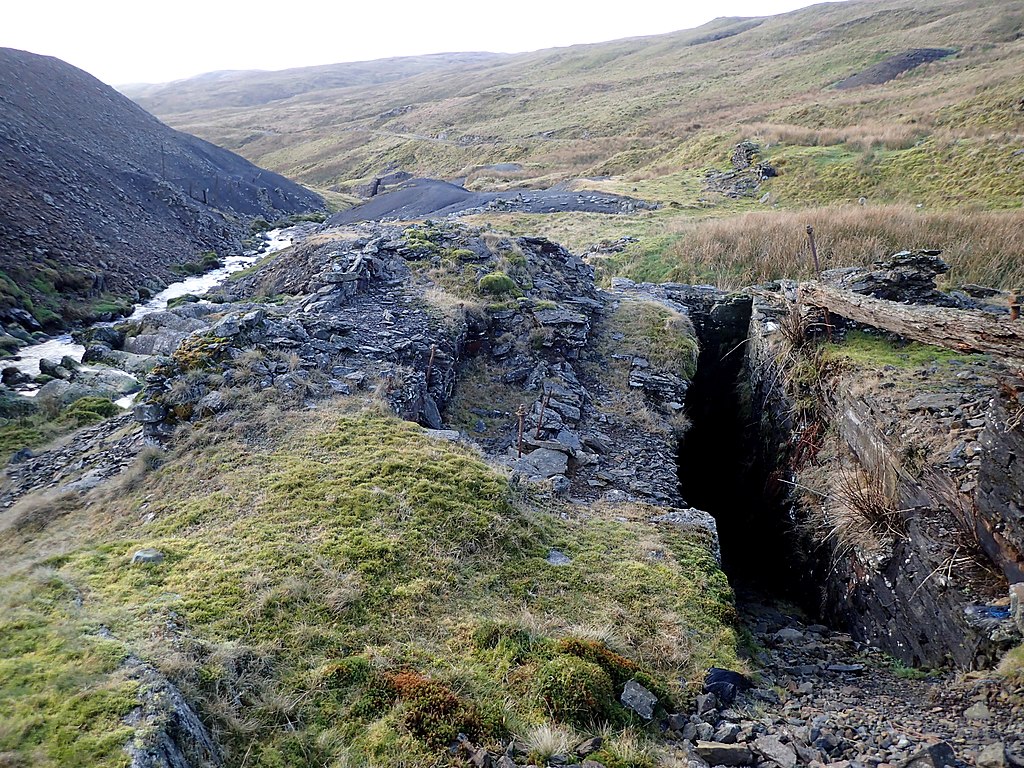Reached by a rough track from Eisteddfa Gurig.
Tramroads, wheelpits and shafts. Dumps has good galena samples.
| Year | Activity |
|---|---|
| 1866 | Production started after a miner found a 3“ rib of galena in the stream. 155fm long adit driven in good ore. |
| 1870 | New company takes possession by which time 1,000 tons of ore had already been sold. 1 foot wide rib of galena showing in the 12fm level. New 50’ waterwheel installed for pumping, original wheel being used for crushing and winding. |
| 1871 | Due to unreliable water supplies, 18“ horizontal steam engine installed for the sum of £700 and connected to the pumping wheel. |
| 1873 | John Paull suceeded as manager by Capt. John Garland. Major difficulty in finding miners to work at such a desolate location. |
| 1875 | At AGM, it was revealed that the engine had been almost useless, the pumping wheel almost shook to pieces and there were breakages in the line of flat rods. The main issue though was lac of water for pumping. |
| 1876 | A total of £38,000 of ore had been raised by end of this year, but profit was not being made. Pumping was done via system of wire ropes driven by the wheel to the pumps via the adit. In December, the resrvoir burst. |
| 1878 | The 36fm level turns out poorer than expected and lead prices starting to drop. Mine closes. |
| 1887-1891 | Raised 195 tons of ore. |
| 1895 | Some working. Final closure. |
Publications (13)
- (1922); BGS - Mineral Resources of GB (c1920s) Vol XX - Lead and Zinc: Cardiganshire & West Montogmeryshire; 242 pages
- (1988); WMS Newsletter Issue 18 May; 12 pages
- (1994); CATMHS - Newsletter 039-July; 37 pages
- (2004); WMS Newsletter Issue 50 Spring; 40 pages
- (2005); WMS Newsletter Issue 52 Spring; 28 pages
- Bick, D.E. (1991); Old Metal Mines of Mid-Wales, The; South of Goginan - Part 2; pp. 6-8
- Edited by D. J. Linton (2012); Welsh Mines & Mining - Towards a Better Understanding - New Research on Old Mines; 152 pages
- Foster-Smith, J.R.; NMRS (1979); British Mining 12 - Mines of Cardiganshire, The; ISBN 0 901450 14 6; pp.49
- Liscombe & Co (1880); Mines of Cardiganshire, Montgomereyshire & Shropshire; 52 pages
- Murchison, J.H. (1869); Lead Mines as an Investment; 34 pages
- NMRS; British Mining 41 - Memoirs 1990; pp.64.
- NMRS; British Mining 80 - Memoirs 2006; pp.70-72,74-75.
- NMRS; Newsletter Sep/1977; pp.5.



